筆記型電腦
| 這是Junjie Yuan的使用者沙盒。使用者沙盒是使用者頁面的子頁面,屬於使用者的測試區,不是維基百科條目。 公用沙盒:主沙盒 | 使用指南沙盒一、二 | 模板沙盒 | 更多…… 此使用者沙盒的子頁面: 外觀選項: 用字選項: 如果您已經完成草稿,可以請求志願者協助將其移動到條目空間。 |
翻譯狀態:施工中······(譯自835641215)
此條目需要補充更多來源。 (2008年10月12日) |
| 「筆記型電腦」的各地常用名稱 | |
|---|---|
 一臺蘋果的MacBook Pro 筆電 | |
| 中國大陸 | 筆記本電腦(筆記本) |
| 臺灣 | 筆記型電腦(筆電) |
| 港澳 | 手提電腦 |

筆記型電腦(英語:Notebook Computer,簡稱為:Notebook PC、Notebook、NB),中文又稱筆電、手提或膝上電腦(英語:Laptop Computer,可簡為Laptop)其中Notebook,筆記型一稱只在中文區比較通行,其他地區如英美日較常用Laptop,是一種小型、可以方可攜式帶的個人電腦,通常重達1至3公斤,亦有不足1公斤者。最早商業化銷售的現代筆記型電腦是PowerBook 100。[來源請求]此前的世界第一台可攜式電腦Macintosh Portable體形巨大,並不受消費者歡迎。現在的發展趨勢是體積越來越小,重量越來越輕,而功能卻越發強大。為了縮小體積,筆記型電腦通常擁有液晶顯示器(液晶屏),現在新型的部分機種甚至有觸控螢幕。除了鍵盤以外,還裝有觸控板(touchpad)或觸控點作為定位裝置(Pointing device)。
就現在來看,筆記型電腦從用途上一般可以分為4類:商務型、時尚型、多媒體應用、特殊用途。商務型筆記型電腦的特徵一般可以概括為行動性強、電池續航時間長;時尚型外觀特異也有適合商務使用的時尚型筆記型電腦;多媒體應用型的筆記型電腦是結合強大的圖形及多媒體處理能力又兼有一定的行動性的綜合體,市面上常見的多媒體筆記型電腦擁有獨立的較為先進的顯示卡,較大的螢幕等特徵;特殊用途的筆記型電腦是服務於專業人士,可以在酷暑、嚴寒、低氣壓、戰爭等惡劣環境下使用的機型,多較笨重[來源請求]。
歷史
[編輯]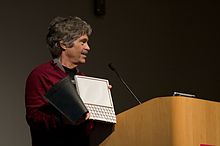
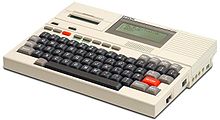
隨著個人電腦(PC)在1971年變得可行,可攜式個人電腦的想法亦隨之而來。1968年,Alan Kay在Xerox PARC設想了一種「個人可攜式資訊操縱器」,[1] 並在其1972年的論文中稱其為「Dynabook」。.[2] IBM於1973年進行了演示特殊電腦可攜式APL機器(SCAMP),該原型基於IBM PALM處理器。[3] 於1975年9月出現發布的IBM 5100是第一台商用可攜式電腦,其基於SCAMP原型。[4]
隨著8位元CPU機器的普及,可攜式機的數量迅速增加。The first laptop-sized notebook computer was the Epson HX-20,[5][6] invented (patented) by Suwa Seikosha's Yukio Yokozawa in July 1980,[7] introduced at the COMDEX computer show in Las Vegas by Japanese company Seiko Epson in 1981,[8][6] and widely released in 1982.[6][9] It had an LCD screen, a rechargeable battery, and a calculator-size printer, in a 1.6公斤(3.5磅) chassis, the size of an A4 notebook.[6] It was described as a "laptop" and "notebook" computer in its patent.[7]
The portable micro computer Portal of the French company R2E Micral CCMC officially appeared in September 1980 at the Sicob show in Paris. It was a portable microcomputer designed and marketed by the studies and developments department of R2E Micral at the request of company CCMC specializing in payroll and accounting. It was based on an Intel 8085 processor, 8-bit, clocked at 2 MHZ. It was equipped with a central 64K bite Ram, a keyboard with 58 alpha numeric keys and 11 numeric keys ( separate blocks ), a 32-character screen, a floppy disk : capacity = 140 000 characters, of a thermal printer : speed = 28 characters / second, an asynchronous channel, a synchronous channel, a 220V power supply. It weighed 12 kg and its dimensions were 45cm x 45cm x 15cm. It provided total mobility. Its operating system was the aptly named Prologue.

The Osborne 1, released in 1981, was a luggable computer that used the Zilog Z80 and weighed 24.5英磅(11.1公斤).[10] It had no battery, a 5英寸(13 cm) cathode ray tube (CRT) screen, and dual 5.25英寸(13.3 cm) single-density floppy drives. Both Tandy/RadioShack and Hewlett Packard (HP) also produced portable computers of varying designs during this period.[11][12] The first laptops using the flip form factor appeared in the early 1980s. The Dulmont Magnum was released in Australia in 1981–82, but was not marketed internationally until 1984–85. The US$8,150 (US$25,730 today) GRiD Compass 1101, released in 1982, was used at NASA and by the military, among others. The Sharp PC-5000,[13] Ampere[14] and Gavilan SC released in 1983. The Gavilan SC was described as a "laptop" by its manufacturer,[15] while the Ampere had a modern clamshell design.[14][16] The Toshiba T1100 won acceptance not only among PC experts but the mass market as a way to have PC portability.[17]
From 1983 onward, several new input techniques were developed and included in laptops, including the touchpad (Gavilan SC, 1983), the pointing stick (IBM ThinkPad 700, 1992), and handwriting recognition (Linus Write-Top,[18] 1987). Some CPUs, such as the 1990 Intel i386SL, were designed to use minimum power to increase battery life of portable computers and were supported by dynamic power management features such as Intel SpeedStep and AMD PowerNow! in some designs.
Displays reached 640x480 (VGA) resolution by 1988 (Compaq SLT/286), and color screens started becoming a common upgrade in 1991, with increases in resolution and screen size occurring frequently until the introduction of 17" screen laptops in 2003. Hard drives started to be used in portables, encouraged by the introduction of 3.5" drives in the late 1980s, and became common in laptops starting with the introduction of 2.5" and smaller drives around 1990; capacities have typically lagged behind physically larger desktop drives. Optical storage, read-only CD-ROM followed by writeable CD and later read-only or writeable DVD and Blu-ray players, became common in laptops early in the 2000s.
基本組成
[編輯]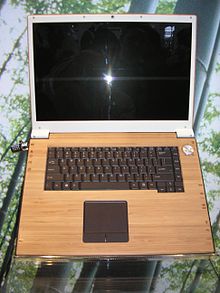
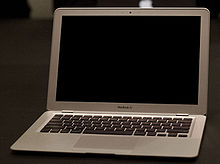
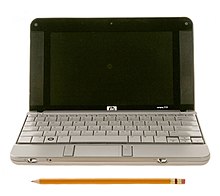

- 外殼:外殼除了美觀外相對於桌上型電腦更起到對於內部器件的保護作用。較為流行的外殼材料有:工程塑料、鎂鋁合金、碳纖維複合材料(碳纖維複合塑料)。其中碳纖維複合材料的外殼兼有工程塑料的低密度高延展及鎂鋁合金的剛度與封鎖性,是較為優秀的外殼材料。一般硬體供應商所標示的外殼材料是指筆記型電腦的上表面材料,托手部分及底部一般習慣使用工程塑料。
- 液晶螢幕:筆記型電腦從誕生之初就開始使用液晶屏作為其標準輸出裝置,其分類大致有:STN、薄膜電晶體液晶顯示器(TFT)等。現今民用級別的液晶屏較為優秀的有夏普公司的「超黑晶」,東芝公司的「低溫多晶矽」和蘋果公司的高解析度「Retina顯示器」等。這幾款都是薄膜電晶體液晶顯示器液晶屏,其中蘋果的Retina顯示器還使用了IPS技術。除了螢幕外液晶屏的發光裝置也是非常的重要,品質較差的燈管會使得液晶屏的色溫偏差非常的嚴重(主要是發黃或者發紅)。
- 中央處理器(CPU):CPU是個人電腦的核心裝置,筆記型電腦也不例外。和桌上型電腦不同,筆記型電腦的CPU除了速度等效能指標外還要兼顧功耗。不但CPU本身便是能耗大戶,由於溫度升高而升高的筆記型電腦的整體散熱系統的能耗也不能忽視。
- 散熱系統:筆記型電腦的散熱系統由導熱裝置和散熱裝置組成,其基本原理是由導熱裝置(現在一般使用熱管)將熱量集中到散熱裝置(現在一般使用散熱片及風扇,也有使用水冷系統的型號)散出。少為人知的散熱裝置還有鍵盤,在敲打之間鍵盤也將散去大量的熱量。不過,由於筆記型電腦散熱系統非常細小,用久了容易積滿灰塵,導致散熱系統效能減退,風扇噪音增加,嚴重更會令風扇停頓,導致CPU過熱。所以筆記型電腦散熱系統是要不時打理。
- 定位裝置(Pointing device):筆記型電腦一般會在機身上搭載一套定位裝置(相當於桌上型電腦的滑鼠,也有搭載兩套定位裝置的型號),早期一般使用軌跡球作為定位裝置,現在較為流行的是觸控板(Touchpad)與指點杆。由於Windows 8特別強化適用於觸控式螢幕的平板電腦設計,所以一部分筆記型電腦開始增加觸控式螢幕作為新的定位裝置。
參見
[編輯]參考文獻
[編輯]- ^ John W. Maxwell. Tracing the Dynabook: A Study of Technocultural Transformations (PDF). 2006 [17 October 2008]. (原始內容 (PDF)存檔於24 January 2007).
- ^ Alan C. Kay. A Personal Computer for Children of All Ages (PDF). 1972 [17 October 2008].
- ^ IBM Personal Computer. IBM Inc.
- ^ IBM 5100 computer. oldcomputers.net. [6 July 2009].
- ^ Epson SX-20 Promotional Brochure (PDF). Epson America, Inc. 1987 [2 November 2008].
- ^ 6.0 6.1 6.2 6.3 【Shinshu Seiki / Suwa Seikosha】 HC-20, Information Processing Society of Japan
- ^ 7.0 7.1 FR2487094A1 patent: Notebook computer system small
- ^ Epson HX-20, Old Computers
- ^ Michael R. Peres, The Focal Encyclopedia of Photography, page 306, Taylor & Francis
- ^ Osborne 1, Old Computers
- ^ Tandy/Radio Shack model 100 portable computer. oldcomputers.net. [6 July 2009].
- ^ Hewlett-Packard model 85. oldcomputers.net. [6 July 2009].
- ^ Sharp PC-5000, Old Computers
- ^ 14.0 14.1 Bob Armstrong, http://cosy.com/language/cosyhard/cosyhard.htm
- ^ Gavilian SC computer. oldcomputers.net. [7 July 2009].
- ^ Japanese PCs (1984) (13:13), Computer Chronicles
- ^ Milestones:Toshiba T1100, a Pioneering Contribution to the Development of Laptop PC, 1985
- ^ Linus Write-Top. [18 October 2008].
外部連結
[編輯]
